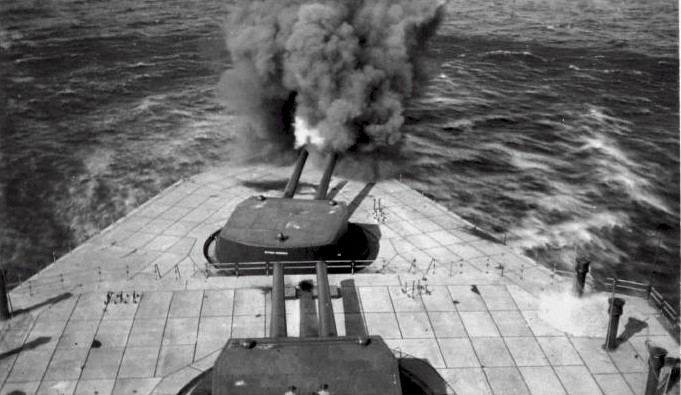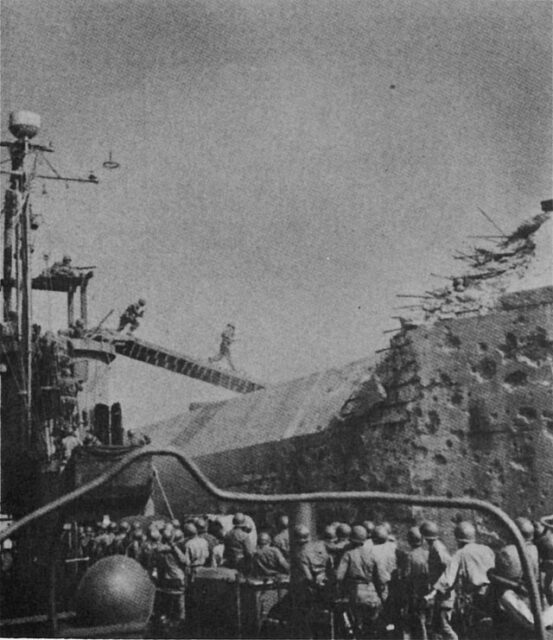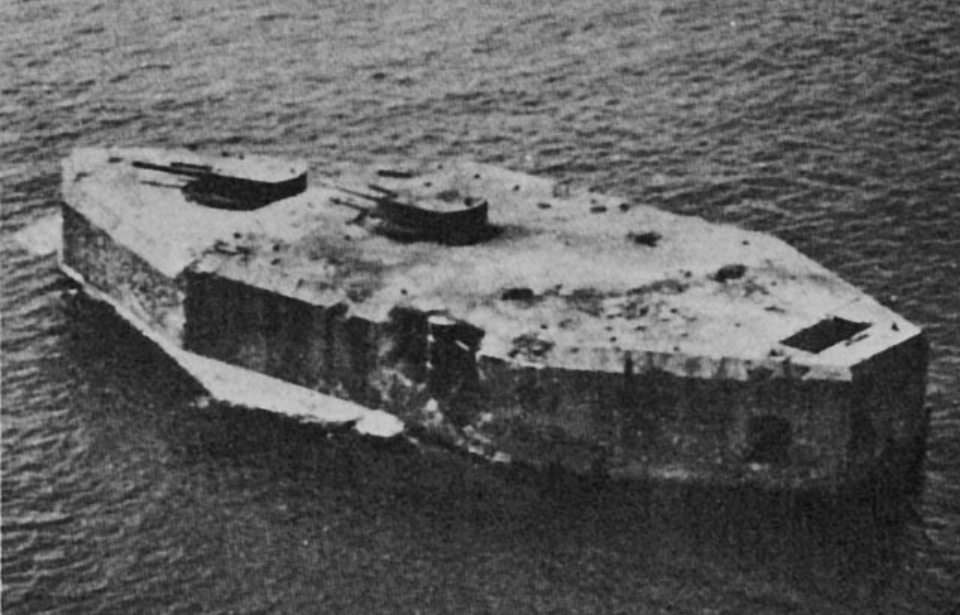Known as El Fraile, Fort Drum was a heavily fortified island under US control in the Philippines. Constructed between 1909-14, this imposing “concrete battleship” featured a designed reinforced concrete structure. Famous for its strong defenses and nearly impregnable nature, the fort played a crucial role in the Second World War, becoming the location of intense combat throughout the conflict.
Battle of Manila Bay

On the evening of April 30, 1898, during the Spanish-American War, Commodore George Dewey led a US Navy squadron into Manila Bay. Spanish guns on El Fraile Island opened fire on the USS McCulloch, prompting her crew to return fire. By lighting the area with a flare, the crew also assisted the USS Boston (1884), Raleigh (C-8) and Concord (PG-3) in retaliating against the island. Despite drawing enemy fire, the American ships successfully navigated through.
The subsequent day witnessed the Battle of Manila Bay, a naval engagement between American and Spanish forces, resulting in the American occupation of the bay. This marked the beginning of the Philippine-American War from 1899-1902 and the Moro Rebellion from 1899-1913, during which the US occupied the entirety of the Philippines.
Design of Fort Drum

Under the guidance of then-Secretary of War William Howard Taft, the Board of Fortifications recommended building fortified defenses in the bays and harbors acquired during the Spanish-American War. Originally designated as a mine control and casemate station, El Fraile underwent a change in plans due to the region’s insufficient defenses, leading to its transformation into a fort resembling a concrete battleship.
The island was leveled, and a reinforced concrete structure was erected, featuring four guns housed in two turrets. Named “Fort Drum” after Brig. Gen. Richard C. Drum, the original plan called for mounting four 12-inch guns on twin armored turrets, later amended to four 14-inch guns. In addition to the primary armament, the fort was equipped with four 6-inch guns and two 3-inch mobile anti-aircraft guns.
Fort Drum boasted robust protection, rendering it virtually impregnable. The top deck exhibited a thickness of 20 feet, with walls ranging from 25-36 feet in width, depending on the location – all constructed from steel-reinforced concrete.
Construction of Fort Drum

In April 1909, the construction of Fort Drum began. As previously mentioned, the overall layout mirrored that of a battleship, spanning 350 feet in length and 140 feet in width. Specially crafted guns were installed in 1916, complemented by a 60-foot lattice-style fire control tower on the upper deck. The living quarters for the 240 fort personnel were situated in the fort’s depths.
Distinguished US servicemen lent their names to the fort’s batteries. Two honored Brig. Gen. William Louis Marshall and John Moulder Wilson, recipients of the Medal of Honor and veterans of the American Civil War. The third battery bore the name of Chief of Artillery Benjamin K. Roberts, while the fourth paid tribute to Artillery Officer Tully McCrea.
Philippines Campaign (1941-42)

After the Japanese invasion of Luzon in late December 1941, Fort Drum found itself in range of the advancing enemy. Managing the fort was the 59th Coast Artillery Regiment (E Battery), stationed there since December 7. Wooden barracks had been erected on the top deck before the onset of the Second World War, but these were dismantled in anticipation of the approaching Japanese forces.
On January 2, 1942, Fort Drum successfully resisted Japanese air bombardments. Several days later, to safeguard the rear of the concrete battleship, Fort Frank transferred a three-inch M1903 gun. On January 13, Fort Drum made history as the first concrete emplacement to open fire on the enemy during World War II, engaging a Japanese steamer attempting to survey the rear.
The installation faced intense enemy fire again in February 1942, destroying the anti-aircraft battery, disabling one of the six-inch guns and significantly damaging the structure. While the fort’s main turrets remained operational, they proved ineffective against the Japanese forces.
Following the fall of Bataan, Fort Drum and similar installations were among the few areas remaining under US control, as the majority of the Philippines had been occupied by the Japanese. On May 5, the enemy launched another attack, suffering heavy casualties from its 14-inch guns. Despite the valiant defense, Corregidor fell the next day, and Fort Drum was surrendered.
Before relinquishing control to the Japanese, the Americans disabled the fort’s guns, rendering them useless. Remarkably, during the conflict, only five injuries were sustained by those stationed on the concrete structure.
Recapture of Fort Drum

The Japanese occupation of Fort Drum persisted until 1945.
As part of the American offensive to recapture Manila, the fort marked the final Japanese stronghold within Manila Bay. On April 13, following extensive aerial and naval bombardments, the American forces launched an assault on the fort. Once ashore, they swiftly regained control, effectively entrapping the Japanese troops inside.
Company F, 2nd Battalion, 151st Infantry Regiment, 38th Infantry Division, attached to the 113th Combat Engineer Battalion, undertook the task of attacking Fort Drum after their successful capture of Fort Hughes on Caballo Island. To accomplish this, they employed White phosphorus mortar rounds to ignite a volatile mixture of 2,500 US gallons, consisting of two parts diesel and one part gasoline, which had been pumped into the structure through a vent.
This technique was adapted for Fort Drum. After the fuel mixture had been injected, a timed fuse and 600 pounds of TNT were used to demolish the structure. The resulting explosion was of such magnitude that it propelled a one-ton hatch 300 feet into the air, and it blew sections of the reinforced concrete apart.
The American forces had to wait for five days before entering Fort Drum, due to the intense fire and heat. This operation led to the demise of all Japanese soldiers inside The recapture of Fort Drum, along with other strongholds in Manila Bay, marked the conclusion of Japanese resistance in the region.
Fort Drum since the Second World War

At the conclusion of the Second World War, the US military abandoned Fort Drum. Having suffered significant damage during the conflict, the process of killing the Japanese soldiers who’d occupied the fort resulted in the gutting of the whole installation.
Want War History Online‘s content sent directly to your inbox? Sign up for our newsletter here!
Since the end of the war, looters have taken metal from Fort Drum, due to its high resale value. That being said, the concrete battleship in Manila Bay remains an enduring symbol of the American occupation of the Philippines.
